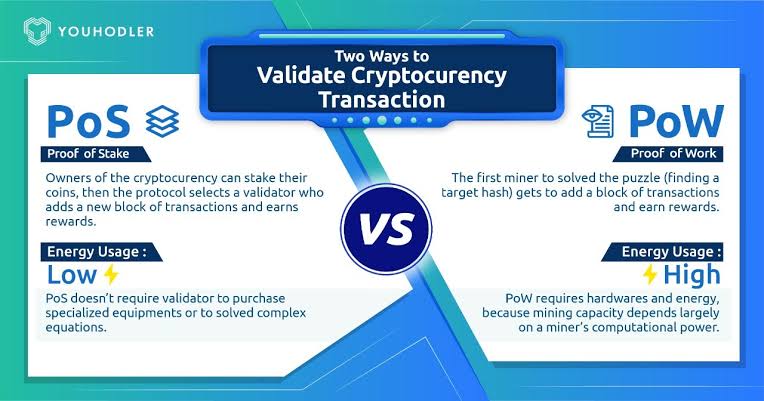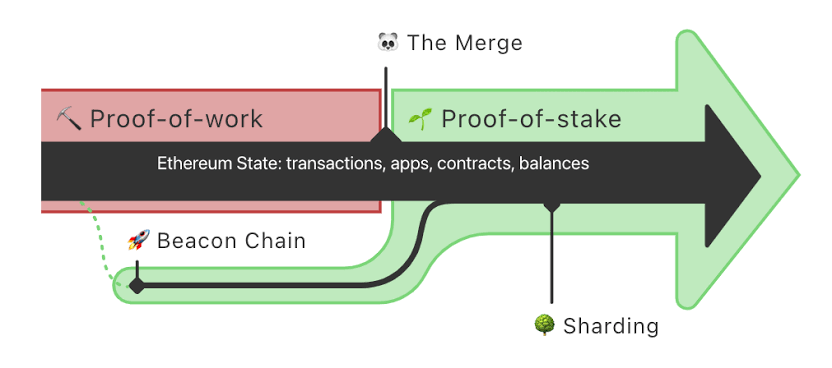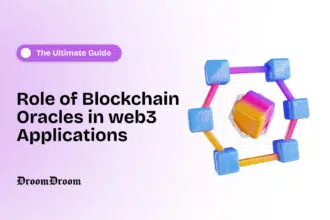Blockchain technology operates by decentralizing users’ activities. Since the system lacks the presence of a middleman, there is a need to validate users’ transactions in a decentralized way.
The Ethereum blockchain has always used the Proof of Work (POW) mechanism to validate users’ transactions. However, developers introduced the Ethereum Merge to migrate the blockchain system from a Proof of Work to a Proof of State mechanism.
Why was the Proof of Stake (POS) introduced, and what advantage does it have over POW? Read on for a detailed explanation of this transition and the implications of the Ethereum Merge.
What is Ethereum Merge?
The merge is the most significant Ethereum upgrade and most talked about events in the crypto space because it completely reshapes how Ethereum functions.
Jake Boyle, Coo of Caleb & Brown
The Ethereum Merge refers to introducing the Proof of Stake mechanism into the Ethereum blockchain system against the former Proof of Work mechanism. Before the Merge, the blockchain system utilizes a large volume of energy, leaving some carbon footprints. Thus, the Merge helps in changing energy dynamics, as well as positively impacting the green ecosystem.
For a more relatable explanation, Ethereum Merge is just like a software update, the same way your computer or mobile phone updates its operating system. However, this is a much bigger transition, which developers have been planning since 2014.
Proof of Work Vs. Proof of Stake

Proof of Work was the first mechanism initiated on Bitcoin in 2008. It involved a mining procedure that rewards successful miners with new blocks on the blockchain. Thus, every miner must solve complex algorithms to verify a crypto transaction. The drawback to this mechanism is the high energy requirement.
Instead of mining, Proof of Stake allows validators to stake a certain amount of tokens to verify transactions. The scheme is similar to a lottery process where the winning chance is equivalent to the number of tokens being staked.
Read this article to learn more about the differences between Proof of Work and Proof of Stake.
When Was the Ethereum Merge Introduced?
The Ethereum Merge was introduced on the 15th of September, 2022, which marked the end of the Proof of Work mechanism on the Ethereum blockchain. However, the Ethereum Merge wasn’t actualized until a side chain called Beacon Chain was introduced in December 2022. Thus, the Ethereum Merge was successful only when the Beacon Chain integrated with Ethereum’s main net.
Implications of the Ethereum Merge
The Ethereum Merge was designed to improve users’ experience by reducing the blockchain’s loading time. Below are other implications of the Ethereum Merge.

Reducing Energy Usage
Energy reduction is the most prominent implication of the Ethereum Merge. Bitcoin and Ethereum were the most energy-intensive cryptocurrencies. However, the report shows that the new mechanism reduced Ethereum’s Energy consumption to 0.01 Terawatts from its yearly consumption of 93.98 Terawatts.
It May Prevent Inflation
Since the Proof of Stake mechanism doesn’t involve rewarding miners with coins like Bitcoin, experts believe it may help curb inflation. Here is an article that further explains Bitcoin mining and how it works.
Experts believe that the staking mechanism will yield a higher burning rate than production rate, which may reduce inflation as well. This is because staking reduces the number of coins in circulation, which is an advantage to investors who love to take advantage of token scarcity.
Since the new way of recording information involves locking up cryptocurrency, a lot of Ethereum investors are speculating that Ether will become deflationary in the process, thus driving up its value.
Gregory Keogh, Vice President of customer success at Curios.
Increased Block Production
The Ethereum blockchain has improved since the Ethereum Merge launch, with about an 18% increase in daily production and a 13% decrease in verification time. This block production improvement also helps increase transaction speed throughout the network. You can read this article published by DroomDroom, for better understanding on how block confirmation works.
In the long run, more people will be encouraged to participate in Ethereum’s decentralization system. In fact, Ethereum has about 687,716 active validators as of the time of writing, with new slots reopening every 12 seconds.
Concerns Regarding Ethereum Merge
As much as Ethereum Merge is known for its positive impact, there have been some concerns from experts or market observers.
Reduced Decentralization
Many of the Ethereum community argue that Ethereum’s migration to the Proof of Stake mechanism would significantly reduce its decentralization property. This is mainly because the blockchain machine will focus more on the wealth of stakes rather than some computational maths problem. Thus, people are quite concerned that a few, yet powerful entities now have the added advantage of being the major players within the ecosystem.
Some argue that the PoS mechanism will easily allow stakers to manipulate the system; others believe such an event is also possible with PoW. However, since bad actors can be punished by confiscating their stakes, it can help curb manipulative attacks. Developers are also encouraged in this DroomDroom’s article, to incorporate best security practices against manipulative attacks.
May Open the Door to New Attacks
Since Proof of Stake is a pretty new development, investors are advised against unforeseen challenges that may lie ahead. Nevertheless, Ethereum’s developmental team is active and prompt in solving rising challenges or issues.
Does Ethereum Qualify as a Security?

It’s no longer news that the Securities and Exchange Commission (SEC) has recently been strict with crypto regulations. Thus, many people fear Ethereum’s transition from PoW to PoS may cause it to be listed as a commodity. More so, the SEC chair, Gary Gensler, said in September 2022 that cryptocurrencies using the Proof of Stake mechanism could be classified as securities. Read this article for a detailed understanding on the Securities and Exchange Commision (SEC) and its operations.
Hours after Ethereum transition to proof-of-stake, SEC Chair says PoS crypto could be classed as securities
September 15, 2022https://t.co/wSut0OP8hc pic.twitter.com/PUBOW3ydAS
— web3 is going just great (@web3isgreat) September 17, 2022Meanwhile, the Digital Commodities Consumer Protection Act referred to Ethereum as a commodity in August 2022.
Conclusion
The crypto community greatly anticipated the launch of the Ethereum Merge, especially to participate in the staking process. However, the impact of this new development on its community cannot be fully known yet. Crypto enthusiasts will keep examining the Ethereum network and its corresponding effect as it pushes into the mainstream.



















